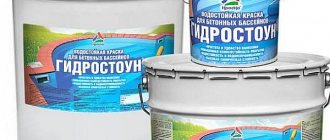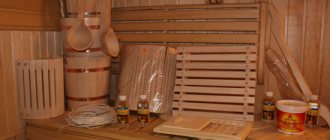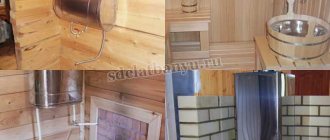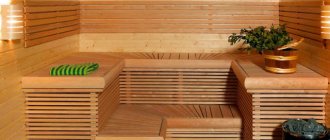When it comes to painting, it is worth distinguishing between what can be used to paint a bathhouse inside and outside. In order to give the most complete picture of the available options, we divided the story into two parts, and the one that is now in front of you is entirely devoted to what to paint the inside of the bathhouse with. And here is a link to the second part, where exterior painting is discussed in equal detail. You can also read the entire section on painting or just the review article on paints suitable for baths.
Types of coatings
Let's look at all possible coatings, regardless of what material they are intended for, because this will be discussed below.
Antiseptic
Mold, unfortunately, does not make much difference between the materials on which it settles, and its harm to human health is a known thing. Therefore, it seems that surfaces need to be treated everywhere, but with some nuances.
IMPORTANT! Antiseptics are poisonous not only to mold, but also to humans!
Finnish bath paint Supi Lattiaolju
And we have said more than once or twice that elevated temperature is an excellent way to make all sorts of chemical hazards volatile, after which they enter your respiratory tract and poison your life.
On the other hand, we have to conclude that the Finns do not like themselves, because in the compositions intended specifically for the steam room, you will find the obligatory antiseptic. Or they found a product that does not evaporate at high temperatures. Or it evaporates, but does no harm. We have no more hypotheses.
In general, the conclusion from all that has been said so far is this: antiseptics are needed everywhere, including in the steam room. But we would still recommend using any type of separately sold antiseptics throughout the bathhouse, except for the steam room, and in the steam room only those paints that are intended only for it . Because we believe in GOSTs and other standards.
Fire retardant
This impregnation, of course, only applies to flammable materials , because it prevents them from igniting or does not allow them to maintain combustion. In general, the main application is the protection of wooden structures.
Fire retardant for interior and exterior treatment
There are only two classes of fire retardants - one suppresses fire for a short time, and if the temperature is exceeded, it loses ground and allows the tree to catch fire, the second is not afraid of heat, it actively protects the tree, releasing gases that cool the surface, creating a layer that prevents oxygen from reaching the wood.
The second class is not so much the composition as the method of impregnation. It should be deep, done under pressure, in general, work for a pro. But in practice, a composition is often used that can be applied manually, which ensures shallow impregnation. But even so, it’s good, because bathhouses burn most often.
INTERESTING! Fire retardants most often contain either boron or urea compounds.
Oil and wax impregnation
Again we are talking about wood. This material has the ability to absorb water, which causes not only swelling, but also warping, and can cause rot. Therefore, it becomes important to make the wood hydrophobic.
oils or can cope with this task . Usually linseed oil is used to impregnate wood , also known as drying oil , but it is not recommended to use drying oil in a steam room. Instead, you can use some store-bought mixture.
Moreover, ready-made formulations can be based either on natural oils or on petroleum distillation products - paraffin oil, for example.
It is also worth paying attention to oil emulsions - these are particles of fat suspended in water, which are convenient to apply to a wooden surface. In general, the consistency of oil impregnations can be different, including a solid substance if wax (then it is called “oil wax”).
It is assumed that impregnations of this kind are a good answer to the question “how to paint a bathhouse inside a steam room,” where they can cover shelves, and, if desired, walls, ceilings, frames, doors and even floors! After absorption and drying, the impregnation guarantees not only protection from water and wood cracking, but also dirt-repellent properties and color preservation.
If the impregnation is based on water , it will have to be renewed more often. You will notice by a change in the properties of the wood that it is time to re-coat.
Dye
All types of paint and varnish products that can be found on the market are applicable in the bath. There are some reasonable restrictions, but not prohibitions.
In total, we have several classes of paints at our disposal:
- enamels;
- oil;
- water soluble.
Enamels are coatings that are so smooth and even that they resemble old enamels. In fact, these are varnishes with covering pigments, which gives an opaque and glassy layer. The varnishes used as the base of enamels are alkyd with various variations: simply alkyd (pentaphthalic and glyphthalic), alkyd-oil, alkyd-phenolic, alkyd-melamine.
In all cases, we are talking about flammable and toxic compounds, the use of which when painting the inside of a bathhouse is recommended only with the possibility of ventilation and the use of respiratory protection during the application process. When using enamel, limit its use to areas other than the steam room.
In fact, oil paints appeared first and a very long time ago - they are a mixture of pigments and drying oils, ultimately forming a hard, water-insoluble film. Typically, the base of oil paint was natural drying oil - for example, linseed oil that had undergone long-term heat treatment. However, over time, artificial drying oils based on alkyd resins appeared.
Today, oil paints can still be purchased, and they are very inexpensive, but they are also flammable, and the solvents used to dilute them have no health benefits.
The restrictions are the same as for enamels.
Water-soluble paints have different bases. These can be acrylic and silicone resins, as well as various composites when, for example, latex or polyurethane is added to acrylic.
Water-soluble paints are based on resins that dissolve well in water before polymerization, but after polymerization do not dissolve at all. (In this case, dissolution should be understood as the formation of a suspension of resin particles in water - similar to milk, for example.)
As mentioned above, paints appeared gradually - oil paints were known (in painting at least) centuries ago, enamels appeared during the intensive growth of the chemical industry, and the current water-based paints are a tribute to technical progress in ecology. In general, quality and safety are increasing as we approach today, but, unfortunately, the price is also increasing along with them.
ADVICE! However, we would still risk recommending water-dispersion paints for painting the inside of a bathhouse.
Lucky
Varnishes are commonly used to coat wood because they provide (unlike paints) a transparent finish (in various shades as desired) that does not hide the natural grain of the wood.
By its nature, varnish is a resin or artificial polymer. Before application to the surface, it is maintained in liquid form by solvents, but they erode during application and the resin film hardens.
Solvents for varnishes were invented in a variety of ways, including different ones in toxicity. Today, water-soluble varnishes are the safest . This is still the same suspension of acrylates in water. However, it forms a transparent film.
Varnishes are used to cover any wooden surfaces, but if we are talking about floors, then you should take into account abrasion (the more people walk in the room, the more it is), and buy varnishes with high wear resistance .
In addition, there are varnishes that are suitable for wet rooms. They can be used in the washing room, and some even in the steam room.
How to choose the right paint
The final result of coating a furnace with paints directly depends on the correctness of its choice. Heat-resistant paint for the stove is selected taking into account the following requirements:
- Firstly, the heat resistance limit of paints and varnishes must be at least 300 degrees. The best solution may be heat-resistant metal paints for furnaces that can withstand temperatures above 600 degrees. Sauna stoves do not heat up that much, but a reserve will not be superfluous. It can be a guarantee that the decorative finish will last for a long time. In most cases, the packaging of such paints and varnishes contains the inscription: “Heat-resistant paint for stoves and fireplaces.”
- Secondly, fireproof paints for stoves have appropriate certificates certifying their quality and ability to withstand high temperatures. You should not trust sellers in this matter. They may simply make mistakes or strive to make money.
- Thirdly, when deciding how to paint iron stoves in a bathhouse, you need to take into account that the paintwork material should not contain substances hazardous to health. When heated, evaporation from the surface occurs tens of times faster. If the paint is of poor quality and contains dangerous components, they will certainly enter the respiratory tract and cause poisoning.
Paint for metal stoves is sold not only in ordinary cans (to apply it you will have to use a roller, brush or spray), but also in spray cans. If you want to paint the stove as quickly as possible, then it is preferable to use the second option.
Types of premises
Fortunately, there are not many rooms in the bathhouse (in a standard one). Therefore, we will quickly go through the options of what paint to paint the inside of the bathhouse.
Steam room
This is the most problematic room. Many believe that there is no need to paint anything at all , but the price for such a decision is rapid darkening of the wood (and almost everyone has a steam room made of wood or lined with wood), cracking of the wood (this happens more often from poor ventilation during drying), susceptibility to rotting and mold damage (linden and aspen are very unstable species).
So the absence of any protective coatings, on the one hand, should be considered environmentally friendly, and on the other, costly in terms of future repairs.
We believe that a compromise is possible: there are absolutely safe impregnations that protect wood, preventing moisture and dirt from being absorbed. If you have doubts about whether it is worth using drying oils, take paraffin oil or another ready-made product intended specifically for the steam room.
You can paint the inside of the steam room with both paints and varnishes, but let them be water-soluble paints. And it would be nice if the label mentioning GOST standards stated that this composition is applicable in the steam room.
Washing
silicone and acrylic paints are suitable here In general, everything that patiently endures the effects of moisture.
Other paints will crack and peel off in pieces under constant exposure to water.
ADVICE! Water dispersions do not tolerate frost well: if the water in the paint freezes, then after defrosting it will lose its quality. Therefore, buy them in the warm season, produced recently.
Impregnations and varnishes are also suitable for painting a sink. Again we draw your attention to scuba gear.
What paint to paint the rest room and dressing room
These rooms are the least demanding on the composition of paints, so it is best to proceed from budgetary considerations. If it doesn’t run out, you can give yourself a gift and use water-soluble paints again, otherwise, choose a paint that is suitable in color, dullness and durability of the coating from cheaper ones.
Of course, in the second case, it is better to paint when it is possible to ensure the best ventilation and the absence of people. Don't forget to use respiratory protection.
IMPORTANT! Remember that enamels and alkyd paints are fire hazards, but water-soluble paints are not.
Types of surfaces and material
Perhaps you don’t want to read the entire article because you are interested in a specific answer to an equally specific question - which paint composition is applicable to this or that part of the room - the ceiling or floor, or walls.
Ceiling
There are no specialized paints just for the ceiling . Usually ceilings are painted with the same paint that is suitable for walls.
If you have wooden ceilings, you may decide to coat them with varnish or acrylate, like Tikkurilov's Supi Saunasuoya.
ATTENTION! Ceiling varnish is suitable without additives that increase its wear resistance, which reduces its price.
If you don’t want to preserve the look and texture of wood, you can use any wall paint. Just remember that in wet rooms you should use paints with special markings. These could be silicone or acrylic paints for bathrooms, for example.
Where it is dry, you can paint the ceiling in a bathhouse with ordinary water-based paint, as for a living room.
Floor
There are only flooring options that can be found in a bathhouse - wood or concrete. The latter is found in damp rooms; it is not always covered with tiles, but as an alternative to tiles it is covered with special paints, for example, paint for concrete pools , which guarantees resistance to water and good adhesion (sticking) specifically to this material.
Paint for concrete pools Hydrostone
As for the wooden floor, here you still have the same choice - either use an opaque composition, or a transparent one - that is, paint or varnish. If the bathhouse is used frequently, then it makes sense to look for a coating with special additives that reduce its abrasion (polyurethane, urethane). Otherwise, you can save money on this.
In principle, the floor is the coldest part even in a steam room, so your choice is not limited by anything (except for humidity, which should be taken into account). You can use alkyd varnishes and paints, even oil-based ones if you want. Yacht varnishes are designed for direct action of water.
The floor in the steam room can be covered with Finnish paints - there are impregnations, varnishes, and acrylate protection on sale.
For those who would like to read more detailed material on floor paints and varnishes, read this article.
Walls
The material of the walls themselves can be very different: wood, brick, blocks. However, they do not remain unfinished, so you will paint either timber/framework, or lining, or, less likely, plaster. The bathhouse is traditionally decorated with wood, but we will still tell you about all the existing options, in case it comes in handy for someone.
Wooden
As already mentioned, wood can be either a direct structural material from which the walls are built, or a finishing material - a thin layer of lining placed on the sheathing. By the way, for reasons of thermal insulation, even log houses are sometimes covered with clapboard inside.
How to paint the lining inside a bathhouse
If you want to enjoy the wooden decor in all its glory, then it is better to paint the lining inside the bathhouse with varnish, for example, aqualak. We're talking about walls, so any other wall you can afford will do.
However, before applying the finishing coat, do not forget to protect the wood from fungi and bacteria, as well as from fire.
ATTENTION! When choosing paint, look to see if it contains a fungicide (kills fungi, including mold) and other protective additives. If it contains additives, pre-treatment is no longer needed.
The lining in the steam room can be coated either impregnation , or with the protective acrylate composition we discussed above. They are tinted, so there will be no problems with choosing a color. You can read about impregnations in general here. Here is an article that talks exclusively about painting bath walls.
In general, there is a practice when the lining is coated with varnish, paint or a protective compound on all sides for the first time before installation, and for the second time only on the front side - after.
How to paint a timber bathhouse inside
If the owner of a bathhouse built it from timber or logs, and decided that it is sufficiently insulated without additional tricks, then he will have to make a number of efforts to ensure that the timber or log does not crack or be damaged by insects and fungi.
To do this, it is necessary to treat all rooms with an antiseptic, except for the steam room. Fire retardant - optional. But it is worth remembering that the depth of penetration of the composition is also important for impregnations, so the antiseptic in the paint in this case may not be enough.
Before painting the inside of a timber bathhouse, you should first remove the top layer - this will clean the wood, reveal its texture, after which you may want to preserve it and use either oil impregnations or varnishes.
We repeat: in dry rooms you can use any paints you like; in wet rooms - only those intended for bathrooms or yacht varnishes. In the steam room, it is advisable to use colors that were developed only for it - focus on the Finns, their sauna is hotter than a Russian bath.
Yes, it’s also worth saying that the answers to the questions “how to paint a bathhouse made of logs inside”, “how to treat it” are exactly the same as regarding the timber.
Brick walls
It is very difficult to imagine a brick wall inside a bath without finishing, except for the cutting wall that is erected in the steam room, wanting to bring the firebox into the next room so that it creates the illusion of a fireplace there.
The cutting wall can easily do without finishing , especially if we are talking about the side that goes into the steam room. But if desired, and for the sake of design, it can be painted, for example, with heat-resistant silicone enamel, but, of course, designed for temperatures much lower than the enamel, which will be discussed below in the chapter on painting stoves.
On the side of, say, a rest room, the brick can be treated not with paint, but with the so-called “ clinker oil ” - it enhances the natural color, gives it depth, and protects the wall from dirt. The composition includes drying oil, turpentine and resins .
Stone walls
But the stone wall in the bathhouse is definitely a decorative element. This could be stone tiles, which, by the way, do not need any painting, or pebbles beautifully laid on the wall.
In the latter case, it is appropriate to resort to some tricks with painting, because unpolished stone looks dull and colorless. acrylic or can be used to enhance the color .
Furnaces
Not only the bathhouse, but also what is commonly called its “heart” - the stove - needs painting. And not only iron, by the way.
Iron
Of course, factory ones come painted, but there are also many homemade stoves made from scrap materials, steels with different carbon contents that are prone to corrosion .
In order to protect your stove from thermal and water corrosion, it would be good to cover it with heat-resistant paint . On the market you will find it under the name “organosilicon enamel”. It can be designed for different temperatures - from the maximum temperatures of a conventional radiator to 1000 degrees of some solid fuel heating boiler that runs on coal.
For a sauna stove, you should take enamel with maximum temperatures of 650-1000 degrees. You can cover it just for protection in one layer, but the appearance depends on the hiding power -
if the look is good, then one layer is enough, and if it turns out unevenly, do a second one.
On sale you can find enamels of different colors, not just black. By the way, it is clear that black objects absorb different radiation better (say, visible light and infrared), but where does the idea come from that they also emit it better?
In addition to painting, you can use the old method of bluing to protect against corrosion . For more details, see the article about painting stoves on our website.
Brick
With brick stoves, there are only two options: either whitewashing with lime/chalk, or painting with the same silicone enamel. Only in the case of the latter, again, there is no need to spend money on a high-temperature one - the surface of the brick stove does not heat up too high (unfortunately, we cannot provide exact figures).
By the way, all this applies not only to stoves, but also to screens that cover metal stoves.
Tools and technologies
The main tools for painting with almost any composition have been and will be the following:
- brush;
- roller;
- spray gun.
In addition, you can buy some types of paints in aerosol cans, but their cost is significantly higher than their counterpart in a can.
Brushes come in different types: from natural bristles, artificial and mixed bristles. All of them are used for applying paints to one or another prepared surface. It is better to apply water-soluble paints using artificial bristle brushes; they do not retain water.
The brush is wetted by a third in the paint, on both sides. After that, with short (!) strokes. The direction of the strokes should always be along the grain of the wood.
Rollers are also different:
- foam;
- velor;
- fur;
- polyamide.
With the exception of foam rubber, all can be used for applying paints on any basis; foam rubber is suitable for water-soluble paints and nothing more.
The spray gun is convenient, but not as accessible as brushes and rollers. You will find varieties for water-soluble and alkyd paints, with an upper or lower location of the tank for the spray composition.
The paint is supplied under air pressure from the compressor, so you must first adjust its viscosity (using a solvent), and then adjust the air supply. This is often done experimentally. First, the maximum spraying is set, the flow of paint is checked - if it falls in the smallest drops, everything is fine, otherwise a solvent is added in an amount of 5% of the volume. Check again.
The air supply is calibrated by the type of drips under the stained spot: if they are at the edges, then the air flow should be reduced, if under the middle of the spot, then increase it.
The paint should be applied evenly, perpendicular to the surface, from a distance of 15 to 25 cm . Overlap the layers, but make sure that the width of the overlap is not more than half the area already painted.
Features of choosing a coloring composition for a bath
The difficulty of choosing is due to temperature and humidity. The heat is much stronger in the room closer to the ceiling, and with strong heating, as mentioned earlier, coloring pigments release toxic substances into the air.
Therefore, in a steam room, it is advisable to treat the ceiling and upper part of the room with impregnations. Like paints, they differ in their composition and release form; they can be water- or oil-based.
Before purchasing, it is important to determine the area where it will be used (ceiling, floor, walls, etc.). The choice is also influenced by subsequent processing, namely, whether the surface will subsequently be covered with a decorative layer or not. The next factor is ease of application, as well as the degree of moisture protection. The optimal product is considered to have good moisture-proof and steam permeability properties.
In the steam room, it is advisable to treat the ceiling and upper part of the room with impregnations.











